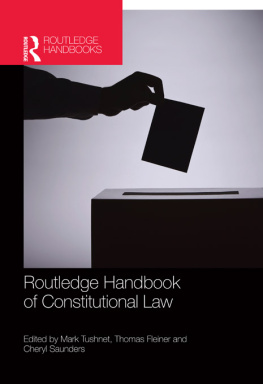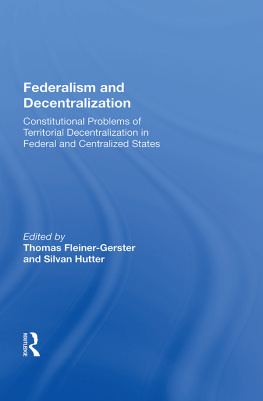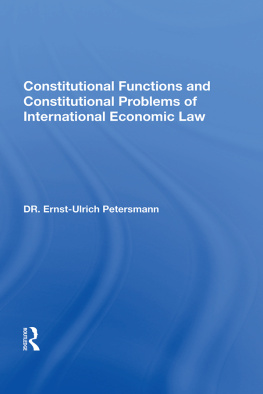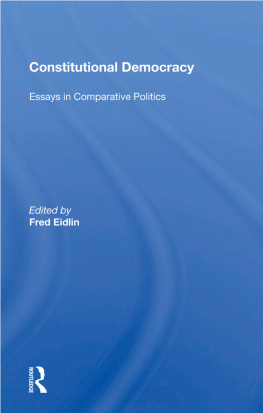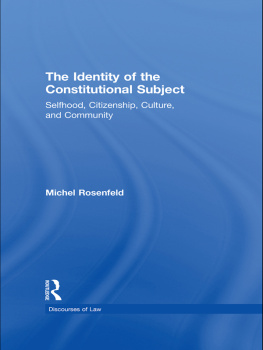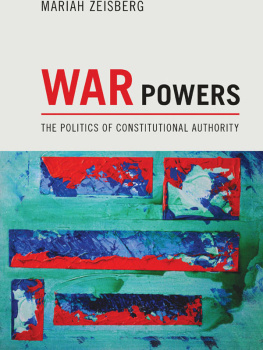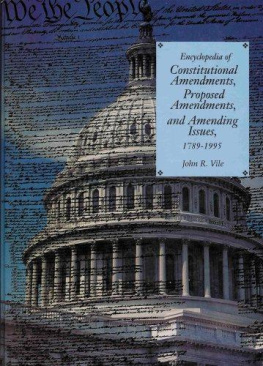First published 2013 by Routledge
2 Park Square, Milton Park, Abingdon, Oxon OX14 4RN
Simultaneously published in the USA and Canada by Routledge
711 Third Avenue, New York, NY 10017
Routledge is an imprint of the Taylor & Francis Group, an informa business
2013 editorial matter and selection, Mark Tushnet, Thomas Fleiner and Cheryl Saunders; individual chapters, the contributors.
The right of Mark Tushnet, Thomas Fleiner and Cheryl Saunders
to be identified as the editors of this work has been asserted by them in accordance with sections 77 and 78 of the Copyright, Designs and Patents Act 1988.
All rights reserved. No part of this book may be reprinted or reproduced or utilised in any form or by any electronic, mechanical, or other means, now known or hereafter invented, including photocopying and recording, or in any information storage or retrieval system, without permission in writing from the publishers.
Trademark notice: Product or corporate names may be trademarks or registered trademarks, and are used only for identification and explanation without intent to infringe.
British Library Cataloguing in Publication Data
A catalogue record for this book is available from the British Library
Library of Congress Cataloging in Publication Data
A catalog record for this book has been requested
ISBN 9780415782203 (hbk)
ISBN 9780203072578 (ebk)
Typeset in Bembo
by RefineCatch Limited, Bungay, Suffolk
Part I
General issues
25
Affirmative action
Robert J Cottrol and Megan Davis
25.1 Introduction
Affirmative action refers to a range of governmental policies designed to foster greater opportunities for racial and ethnic groups that have traditionally been victims of discrimination. These policies are also frequently extended to women and to individuals who have suffered from socio-economic disadvantage. Affirmative action has generally been less controversial when based on class or gender instead of race. Affirmative action policies have taken the form of quotas for members of previously disadvantaged groups, preferential weighting of applicants for employment and university admissions and governmental pressure to increase recruitment of members of groups that have long suffered from discrimination. In some nationsthe United States and the Republic of South Africa are examplesaffirmative action takes place against a background of previous histories of formal, legally mandated discrimination against non-white groups. In other nationsBrazil is an exampleaffirmative action occurs in the absence of a history of formal legal discrimination. In such nations there are often nonetheless very real histories of racial discrimination and stigmatization of and often very strong patterns of racially linked class disadvantage (Cottrol). Affirmative action policies are found in a diverse set of nations in the modern world including such nations as Brazil, Colombia, India, Israel, Malaysia, Nigeria, South Africa and the United States (Sowell, 222).
Affirmative action frequently creates constitutional and judicial dilemmas in the nations that have or contemplate such policies. By the end of the twentieth century, and especially after the fall of South Africas apartheid regime in 1993, the principle of the equality of all citizens before the law had become a virtually universal constitutional norm. But how would affirmative action policies that did confer preferences and benefits on traditionally disfavored groups be reconciled with the equality principle? A strict reading of the equality principle that is found in most modern constitutions would argue that applications for employment or university admissions be judged without regard to race, ethnicity, gender, or a nations previous history of discrimination. Yet such a strict adherence to the equality principle would allow entrenched patterns of social, economic and, in some cases, political inequalities to continue, not taking into account either historic disadvantage, or the very real persistence of It is accepted in international law that the principle of equality
[do]es not require absolute equality or identity of treatment but recognizes relative equality ie, different treatment proportionate to concrete individual circumstances. In order to be legitimate, different treatment must be reasonable and not arbitrary and the onus of showing that particular distinctions are justifiable is on those who make them (McKean).
As Judge Tanaka famously held in the South West Africa Case (Second Phase):
The principle of equality before the law does not mean absolute equality, namely the equal treatment of men without regard to individual, concrete circumstances, but it means the relative equality, namely the principle to treat equally what are equal and unequally what are unequal To treat unequal matters differently according to their inequality is not only permitted but required.
The extent to which this viewpoint has become accepted law in different nations has, of course, depended on the actions of national courts and legislatures, the reception of international human rights law and the era in which constitutional drafting occurred.
This Chapter examines the treatment of affirmative action in the constitutional law of four nations, selected to highlight differences and similarities in connection with the common law or civil law background, and differences and similarities in connection with the historical origins of the conditions that have led policy-makers to develop affirmative action policies.
25.2 United States
Affirmative action in the United States developed out of the civil rights movement and the struggle of black Americans against systematic patterns of segregation and discrimination, frequently mandated by law. In 1865, more than two centuries of slavery on the North American continent would come to an end: the results of Northern victory in the American Civil War. In the wake of that conflict, the US Constitution was amended with three new provisions, specifically designed to provide equal rights for the newly emancipated black population. These provisions included the Thirteenth Amendment, which prohibited slavery, and the Fifteenth Amendment, which eliminated racial restrictions on voting. The new provision that would become the subject of much constitutional litigation was the Fourteenth Amendment, which contained an equal protection clause designed to bring the principle of equal treatment of people of different races into the American constitutional order.
If the period after the American Civil War would see the enactment of constitutional measures designed to equalize the status and treatment of Americans of different races, by the beginning of the twentieth century, the principle of equal treatment under the law was being largely ignored in many parts of the nation. By the beginning of the twentieth century, a system of racial segregation, popularly known as Jim Crow, was developing in the southern states of the America, home to a majority of the nations black population. The Jim Crow system, which at its height would mandate separate railroad coaches, separate seating on buses, separate park benches and water fountains, separate schools and segregation in almost every visible facet of public life, was approved by the US Supreme Court in the 1896 case Plessy v Ferguson. In that case, the Court declared that the equal protection principle was not violated by separate facilities for people of different races as long as the facilities were equal. In the Southern states, and a good part of the rest of the nation, separate facilities were common but equal facilities rare.
The fight against the Jim Crow system would gain increasing momentum after World War II. One important early victory was Brown v Board of Education , the case that declared school segregation unconstitutional and implicitly reversed the separate but equal doctrine of Plessy. The efforts of the Civil Rights movement would ultimately lead to comprehensive national legislation, the Civil Rights Act of 1964 which outlawed many of the then existing patterns of racial discrimination in public accommodations. It also prohibited discrimination on the basis of race and sex in employment.

